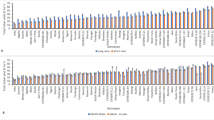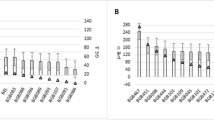Summary
Twenty potato cultivars were tested in replicated trials in three seasons. The weather gradually changed from relatively high humidity and cold air temperatures in February to dry and hot in July. Fresh and dry weights, sucrose, reducing sugar and starch contents were recorded on tubers sequentially harvested over four stages during the growing period of each of the three trials. The data were analyzed for genotype-environment interactions by a path regression model which is composed of a main effect and four multiplicative effects. The model fitted well to the observed data for all traits but reducing sugar. Results of dry tuber weight were used to calculate a heat susceptibility index for each of the cultivars. Four components of the index were identified based on the path model. Comparison of sizes of the components provided information on the degree of response to the environmental stress of each of the cultivars during successive stages of growth. High yielding and heat tolerant cultivars were identified based on the experimental results.
Similar content being viewed by others
References
Adams, M.W., 1967. Basis of yield component compensation in crop plants with special reference to the bield bean, Phaseolus vulgaris. Crop. Sci. 7: 505–510.
Ewing, E.E., 1981. Heat stress and tuberization stimulus. Am. Potato J. 58: 31–49.
Fischer, R.A. & R. Maurer, 1978. Drought resistance in spring wheat cultivars. I. Grain yield responses. Aust. J. Agric. Res. 29: 897–907.
Gauch, H.G., 1988. Model selection and validation for yield trials with interaction. Biometrics 44: 705–715.
Hawkes, J.G., 1978. History of the potato. In: P.M. Harris (Ed.), The Potato Crop. The Scientific Basis for Improvement, Chapman and Hall, London, pp. 1–14.
International Potato Center, 1984, Potato for the Developing World. Lima, Peru, 150 pp.
Ivins, J.D. & F.L. Milthorpe (Eds.), 1963. The Growth of the Potato, Proceedings of the 10th Easter School in Agricultural Sciences, University of Nottingham, Butterworth, London, 328 pp.
Kaldy, M.S., 1972. Protein yield of various crops as related to protein value. Econ. Bot. 26: 142–144.
Kang, M.S. (Ed.), 1990. Genotype-By-Environment Interaction and Plant Breeding, Louisiana State University. Baton Rouge, 392 pp.
Levy, D., 1983. Varietal differences in the response of potatoes to repeated short periods of water stress in hot climates. 2. Tuber yield and dry matter accumulation and other tuber properties. Potato Res. 26: 315–321.
Levy, D., 1984. Cultivated Solanum tuberosum L. as a source for the selection of cultivars adapted to hot climates. Trop. Agric. (Trinidad) 61: 167–170.
Lynch, D.R. & G.C.C. Tai, 1989. Yield and yield component response of eight potato genotypes to water stress. Crop Sci. 29: 1207–1211.
Marshall, H.G., 1982. Breeding for tolerance to heat and cold. In: M.N. Christiansen & C.F. Lewis (Eds.), Breeding Plants for Less Favorable Environments. John Wiley and Sons, New York, NY, pp. 47–70.
Miller, G.L., 1959. Use of dinitrosalicylic acid reagent for determination of reducing sugar. Anal. Chem. 31: 426–428.
Shpiler, L. & A. Blum, 1991. Heat tolerance for yield and its components in different wheat cultivars. Euphytica 51: 257–263.
Stagemann, H. & D. Schnick, 1982. Index 1982 of European Potato Varieties. National Registers, Characteristics, Genetic Data. Kommissionsverlag Paul Parey, Berlin, 219 pp.
Tai, G.C.C., 1979. Analysis of genotype-environment interactions of potato yield. Crop Sci. 19: 434–438.
Tai, G.C.C., 1990. Path analysis of genotype-environment interactions. In: M.S. Kang (Ed.), Genotype-By-Environment Interaction and Plant Breeding. Louisiana University, Baton Rouge, pp. 273–286.
Wright, S., 1921. Correlation and causation. J. Agric. Res. 20: 557–585.
Wright, S., 1934. The method of path coefficients. Ann. Math. Stat. 5: 161–215.
Van der Zaag, D.E. & D. Horton, 1983. Potato production and utilization in world perspective with special reference to the tropics and sub-tropics. Potato Res. 26: 323–362.
Van Handel, E., 1968. Direct microdetermination of sucrose. Anal. Biochem. 22: 280–283.
Author information
Authors and Affiliations
Rights and permissions
About this article
Cite this article
Tai, G.C.C., Levy, D. & Coleman, W.K. Path analysis of genotype-environment interactions of potatoes exposed to increasing warm-climate constraints. Euphytica 75, 49–61 (1994). https://doi.org/10.1007/BF00024531
Received:
Accepted:
Issue Date:
DOI: https://doi.org/10.1007/BF00024531




